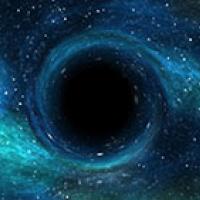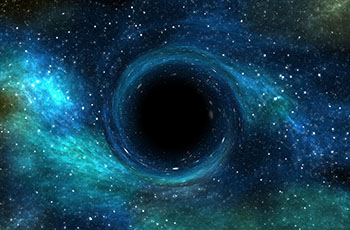
String theory: A promise from physics
"The 20th century was the interaction of geometry and physics, and the 21st century is the interaction of number theory with physics," says Yang-Hui He from the London Institute of Mathematical Sciences. An example of that 20th century interaction is how geometry revolutionised our understanding of the Universe. Specifically the maths of curvature gave Albert Einstein the language he needed to define his general theory of relativity.
But what about the 21st century interaction of number theory and physics? This was a focus of a research programme at the Isaac Newton Institute for Mathematical Sciences in Cambridge that He helped organise. The programme – Black holes: bridges between number theory and holographic quantum information – brought together a fascinating array of experts in black holes, quantum theory, mathematicians and computer scientists. When we spoke to He earlier this year about the programme he wove a fascinating tale of the interplay between physics and mathematics. The thread running through all of these was string theory.
The problem of quantum gravity
"String theory is an attempt to unify the theory of the large – general relativity and cosmology – with the theory of the small – the theory of particle physics," says He. "Somehow it became this rich [mathematical] framework that gave us lots of cool maths and lots of cool physics!" But this attempt to unify the two scales of physics has not been easy.

Artist's impression of a black hole.
On the very largest scales it is the force of gravity that dominates. Einstein's general theory of relativity has given us an incredibly successful understanding of gravity, answering many questions that evolved from Newton's earlier theory. And Einstein's theory gave us some of the most exciting discoveries in the last century – black holes and gravitational waves first emerged as solutions of Einstein's equations of gravity in the early 20th century. But both these cosmological mysteries were only finally experimentally observed in the first decades of the 21st century.
On the smallest scales it is the other three fundamental forces of nature – electromagnetism, and the strong and weak nuclear forces – that come into play. These three forces, and the behaviour of all the fundamental particles – are mathematically described in something called the standard model of particle physics.
The problem comes when trying to tie all four forces together. The mathematics used for describing gravity is not the same as that used to describe quantum physics. We don't have a single mathematical language that can describe all of these four forces – we don't have a mathematical framework for understanding quantum gravity.
The first place physicists look to see quantum gravity in action is in black holes – those mysterious regions in the Universe where gravity is so strong not even light can escape. (You can find out why in the article From steam engines to the limits of physics.) And as well as providing a bridge between the very large scales of gravity and the quantum scales of particle physics, black holes also provide a bridge between the worlds of physics and mathematics.
String theory – promising physics
String theory is an attempt to provide a theory for quantum gravity. Essentially it suggests that at the very smallest scales the fundamental particles, such as electrons, are not like points as we might imagine them. Instead they are more like strings - and the length of these in some sense defines the smallest scale at which we call look at the world.
This very strange idea has lots of consequences. Some are very handy, like making the mathematics used in physics easier. And some consequences are really very strange, such as implying that our Universe has hidden dimensions. Rather than living in the four dimensional world we perceive – consisting of three-dimensional space and one dimension of time – string theory says our Universe has ten dimensions. We don't see these extra dimensions because some of them are curled up so tightly they are hidden from view.
As string theory developed as a possible mathematical approach for understanding quantum gravity it created huge excitement and expectation in the physics community. "In the 70s and 80s everybody was getting into string theory," says He. "This promised to be the story of everything - it's going to solve black holes, quantum gravity, everything."
But after 20 years of waiting for experimental evidence, not a single shred of evidence had been seen. "Of course experimental evidence is difficult," says He. For example, Peter Higgs had to wait 50 years to finally observe his predicted Higgs boson. "But you know, people were like – are we ever going to see a signature [of string theory]?"
Despite the lack of experimental evidence, string theory did continue to have an enormous impact on theoretical physics. A resulting idea area was the mind-bending concept of the holographic principle where gravity is not a force at all, but instead is an illusion conjured up by a quantum hologram. (You can read more about the holographic principle in Quantum gravity in the can.) String theory gave the physicist Juan Maldacena the tool he needed to give the first concrete example of the holographic principle.
String theory – convincing mathematics
Meanwhile exciting things were happening in mathematics that were going to weave together with string theory. String theory requires there to be extra, hidden, tightly curled dimensions in our Universe. When this was first suggested it wasn't known if such twisted geometries could be described mathematically. But luckily mathematician Shin-Tung Yau was busy proving the existence of something called Calabi-Yau manifolds.

A cross-section of a Calabi-Yau manifold. Image: Lunch, CC BY-SA 2.5.
Calabi-Yau manifolds are fascinating mathematical structures that come from the intersection of topology and geometry. The first part of their name is from the mathematician Eugenio Calabi who asked in the 1950s if it was possible to prove that such objects existed. Yau proved that they did in the 1970s and in 1982 was awarded the Fields medal, one of the highest honours in mathematics, for this work. (You can find out more in our article Hidden dimensions.)
Yau's work answered an important mathematical question, but it also solved a problem in string theory – Calabi-Yau manifolds provided the geometric structure that was needed to hide the extra dimensions. When we spoke to Yau in 2010 he reminisced about a day in 1984 when he was in San Diego with his wife looking out at the ocean: "The phone rang and it was my friends, [the physicists] Andrew Strominger and Gary Horowitz. They were excited because string theorists were building up models of the Universe and needed to know whether [Calabi-Yau] manifolds really existed. I was happy to confirm that they did."
Mathematics was providing answers to problems in string theory, but string theory was also proving enormously useful to mathematicians. "It's given so much rich mathematics," says He. "By the early 2000s you talk to any mathematician and he or she will say I'm 100% convinced that string theory is right because we've never encountered a theory of physics that's given us so many problems to work on."
Experimental evidence for string theory may have been hard for physicists to come by, but its impact on mathematics convinced many it was the right direction to follow. Find out more in the next article.
About this article
Yang-Hui He is a Fellow and professor at the London Institute for Mathematical Sciences. He works on the interface between string theory, algebraic geometry, and machine learning.
Rachel Thomas is Editor of Plus.
This content was produced as part of our collaboration with the Isaac Newton Institute for Mathematical Sciences (INI) – you can find all the content from our collaboration here. The INI is an international research centre and our neighbour here on the University of Cambridge's maths campus. It attracts leading mathematical scientists from all over the world, and is open to all. Visit www.newton.ac.uk to find out more.

Comments
Brian J Flanagan
"We don't see these extra dimensions because some of them are curled up so tightly they are hidden from view."
Well, obviously the extra dimensions have to be different somehow because otherwise we would notice them.
~Green
What we see depends on light entering the eye. Furthermore we do not even perceive what enters the eye. The things transmitted are waves or — as Newton thought — minute particles, and the things seen are colors. Locke met this difficulty by a theory of primary and secondary qualities. Namely, there are some attributes of the matter which we do perceive. These are the primary qualities, and there are other things which we perceive, such as colors, which are not attributes of matter, but are perceived by us as if they were such attributes. These are the secondary qualities of matter.
Why should we perceive secondary qualities? It seems an unfortunate arrangement that we should perceive a lot of things that are not there. Yet this is what the theory of secondary qualities in fact comes to.
~Whitehead
https://brocku.ca/MeadProject/Whitehead/Whitehead_1920/White1_02.html